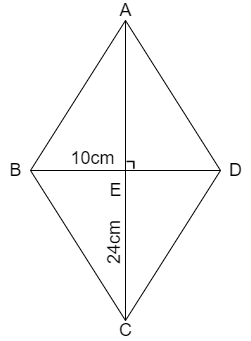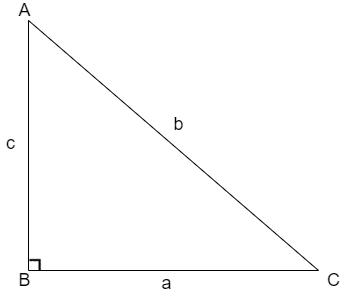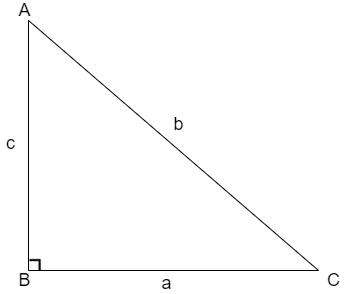
The diagonals of a rhombus are 10cm and 24cm. Find the length of each side of a rhombus.
Answer
558k+ views
Hint: Let us draw a rough figure as follows

We solve this problem by using the definition of rhombus that is all the sides of rhombus are equal. We also use the condition that the diagonals intersect at right angles at mid – points. For finding the side length we use the Pythagoras Theorem states that the square of hypotenuse is equal to sum of squares of other two sides that is for the triangle shown below

The Pythagoras theorem is given as\[{{b}^{2}}={{a}^{2}}+{{c}^{2}}\].
Complete step by step answer:
We are given that the length of diagonals as 10cm and 24cm
Let us assume that from the figure the length of diagonals as
\[\Rightarrow AC=24cm\]
\[\Rightarrow BD=10cm\]
We know that the diagonals of rhombus intersect at right angles at mid – points that means the point ‘E’ is mid – point of both ‘AC’ and ‘BD’
By using the above condition the length of ED can be calculated as
\[\Rightarrow ED=\dfrac{BD}{2}\]
By substituting the required values we get
\[\Rightarrow ED=\dfrac{10cm}{2}=5cm\]
Similarly, by using the condition that point ‘E’ is mid – point of ‘AC’ we get
\[\Rightarrow AE=\dfrac{AC}{2}\]
By substituting the required values we get
\[\Rightarrow AE=\dfrac{24cm}{2}=12cm\]
Now, let us consider the triangle \[\Delta AED\]
We know that the Pythagoras Theorem states that the square of hypotenuse is equal to sum of squares of other two sides that is for the triangle shown below

The Pythagoras theorem is given as\[{{b}^{2}}={{a}^{2}}+{{c}^{2}}\].
By using the Pythagoras theorem to triangle \[\Delta AED\] we get
\[\Rightarrow A{{D}^{2}}=A{{E}^{2}}+E{{D}^{2}}\]
By substituting the required values in above equation we get
\[\begin{align}
& \Rightarrow A{{D}^{2}}={{5}^{2}}+{{12}^{2}} \\
& \Rightarrow A{{D}^{2}}=25+144 \\
& \Rightarrow AD=\sqrt{169}=13cm \\
\end{align}\]
We know that all the sides of a rhombus are equal
By using the above condition we get
\[\Rightarrow AB=AC=CD=DA=13cm\]
Therefore the length of each side of a given rhombus is 13cm.
Note: We can solve this problem in another method.
If \[p,q\] are lengths of diagonals of a rhombus then the area is given as
\[\Rightarrow A=\dfrac{1}{2}\times p\times q\]
If \[p\] is length of diagonal and \[a\] is side length of rhombus the area formula is given as
\[\Rightarrow A=\dfrac{1}{2}\times p\times \sqrt{4{{a}^{2}}-{{p}^{2}}}\]
Since the area will be same in any method by equating them we get
\[\begin{align}
& \Rightarrow \dfrac{1}{2}\times p\times q=\dfrac{1}{2}\times p\times \sqrt{4{{a}^{2}}-{{p}^{2}}} \\
& \Rightarrow q=\sqrt{4{{a}^{2}}-{{p}^{2}}} \\
\end{align}\]
Now by squaring on both sides we get
\[\Rightarrow 4{{a}^{2}}={{p}^{2}}+{{q}^{2}}\]
Now, by substituting the required values we get
\[\begin{align}
& \Rightarrow 4{{a}^{2}}={{10}^{2}}+{{12}^{2}} \\
& \Rightarrow {{a}^{2}}=\dfrac{100+144}{4} \\
& \Rightarrow a=\sqrt{169}=13cm \\
\end{align}\]
Therefore the length of each side of a given rhombus is 13cm.

We solve this problem by using the definition of rhombus that is all the sides of rhombus are equal. We also use the condition that the diagonals intersect at right angles at mid – points. For finding the side length we use the Pythagoras Theorem states that the square of hypotenuse is equal to sum of squares of other two sides that is for the triangle shown below

The Pythagoras theorem is given as\[{{b}^{2}}={{a}^{2}}+{{c}^{2}}\].
Complete step by step answer:
We are given that the length of diagonals as 10cm and 24cm
Let us assume that from the figure the length of diagonals as
\[\Rightarrow AC=24cm\]
\[\Rightarrow BD=10cm\]
We know that the diagonals of rhombus intersect at right angles at mid – points that means the point ‘E’ is mid – point of both ‘AC’ and ‘BD’
By using the above condition the length of ED can be calculated as
\[\Rightarrow ED=\dfrac{BD}{2}\]
By substituting the required values we get
\[\Rightarrow ED=\dfrac{10cm}{2}=5cm\]
Similarly, by using the condition that point ‘E’ is mid – point of ‘AC’ we get
\[\Rightarrow AE=\dfrac{AC}{2}\]
By substituting the required values we get
\[\Rightarrow AE=\dfrac{24cm}{2}=12cm\]
Now, let us consider the triangle \[\Delta AED\]
We know that the Pythagoras Theorem states that the square of hypotenuse is equal to sum of squares of other two sides that is for the triangle shown below

The Pythagoras theorem is given as\[{{b}^{2}}={{a}^{2}}+{{c}^{2}}\].
By using the Pythagoras theorem to triangle \[\Delta AED\] we get
\[\Rightarrow A{{D}^{2}}=A{{E}^{2}}+E{{D}^{2}}\]
By substituting the required values in above equation we get
\[\begin{align}
& \Rightarrow A{{D}^{2}}={{5}^{2}}+{{12}^{2}} \\
& \Rightarrow A{{D}^{2}}=25+144 \\
& \Rightarrow AD=\sqrt{169}=13cm \\
\end{align}\]
We know that all the sides of a rhombus are equal
By using the above condition we get
\[\Rightarrow AB=AC=CD=DA=13cm\]
Therefore the length of each side of a given rhombus is 13cm.
Note: We can solve this problem in another method.
If \[p,q\] are lengths of diagonals of a rhombus then the area is given as
\[\Rightarrow A=\dfrac{1}{2}\times p\times q\]
If \[p\] is length of diagonal and \[a\] is side length of rhombus the area formula is given as
\[\Rightarrow A=\dfrac{1}{2}\times p\times \sqrt{4{{a}^{2}}-{{p}^{2}}}\]
Since the area will be same in any method by equating them we get
\[\begin{align}
& \Rightarrow \dfrac{1}{2}\times p\times q=\dfrac{1}{2}\times p\times \sqrt{4{{a}^{2}}-{{p}^{2}}} \\
& \Rightarrow q=\sqrt{4{{a}^{2}}-{{p}^{2}}} \\
\end{align}\]
Now by squaring on both sides we get
\[\Rightarrow 4{{a}^{2}}={{p}^{2}}+{{q}^{2}}\]
Now, by substituting the required values we get
\[\begin{align}
& \Rightarrow 4{{a}^{2}}={{10}^{2}}+{{12}^{2}} \\
& \Rightarrow {{a}^{2}}=\dfrac{100+144}{4} \\
& \Rightarrow a=\sqrt{169}=13cm \\
\end{align}\]
Therefore the length of each side of a given rhombus is 13cm.
Recently Updated Pages
Master Class 12 Business Studies: Engaging Questions & Answers for Success

Master Class 12 Economics: Engaging Questions & Answers for Success

Master Class 12 English: Engaging Questions & Answers for Success

Master Class 12 Maths: Engaging Questions & Answers for Success

Master Class 12 Social Science: Engaging Questions & Answers for Success

Master Class 12 Chemistry: Engaging Questions & Answers for Success

Trending doubts
Who was the first woman to receive Bharat Ratna?

Write a letter to the principal requesting him to grant class 10 english CBSE

Why is there a time difference of about 5 hours between class 10 social science CBSE

What is the median of the first 10 natural numbers class 10 maths CBSE

The Equation xxx + 2 is Satisfied when x is Equal to Class 10 Maths

Discuss the main reasons for poverty in India




